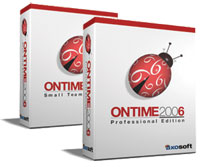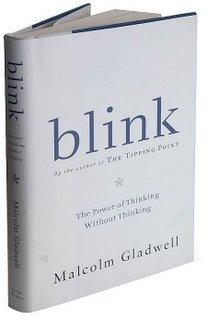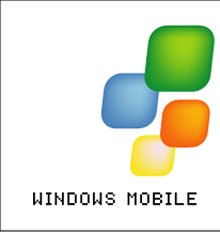Sunday, February 26, 2006
Keep it Simple
Friday, February 24, 2006
Gladwell Blinks, then Blogs
Blackberry Reprieve
Segue to SQL
WWITPRO put on its second event last night at RIM Park in Waterloo, Ontario. Damir Bersinic talked to the group of about 25 IT Pros gathered about Securing SQL Server 2005. Val Matison, guest IT blogger for Microsoft's IT Pro Manager's joint blog, has already outlined the content of the talk quite well, so I won't duplicate those efforts.
Damir did an excellent job presenting and demonstrating security features of SQL Server 2005 (I've come to expect this of him), so WWITPRO is pleased that he is coming back again in March to talk about features of Microsoft VISTA.
The meeting itself was very well organized with opportunities to network with other IT pros, with Microsoft representatives, to snack on veggies and sweets, and even to participate in a draw of door prizes (it seemed that almost everyone attending received an O'Reilly (not Wiley, as I thought) book, a voucher for a free download of Virtual Server, a copy of Encarta, a media keyboard, etc.).
This group looks like it has legs. Stay tuned...
Technorati Tags : SQL, Server, 2005, Damir, Bersinic, WWITPRO, VISTA, Microsoft, Val, Matison
Wednesday, February 22, 2006
Marketing at the speed of blog

As I gear up for promoting business blogging at Pano Cap, one of the most obvious benefits is blog monitoring.
Take Robert Scoble's blog from yesterday for instance - Project Management Software Maker tries Memetracker approach. Scoble reported that Axosoft was marketing a 3-day opportunity to purchase project management software for small teams that would normally cost $495 for a mere $5. Today I visited the Axosoft site, registered, and purchased the project management/bug tracking small-team software - OnTime 2006.
If the testing works well, then I'll have a solution for a help desk application for our company. The Small Team Edition supports 5-member teams as well as a portal for 10 customers. The demo looks attractive (what demo doesn't?).
The entrepreneurial marketing strategy is the most interesting aspect of this. It's driven by blogs, by links, by the speed of the blogosphere. That means that the customer is the one to take the initiative, not the seller. I like that. But the down side to this is that blogs often are insufficiently detailed.
Blogs tend to concentrate on the buzz factor - what's cool, what's new, what's innovative. But business software acquisition is more about careful analysis, not buzz, not even the buzz of virtually free acquisition costs. The true cost of business software comes from implementation, training, and problems of fit. It could be that OnTime 2006 will not meet our needs. After all, it is geared towards software development teams, not IT support teams. But I'm prepared to give Scoble's recommendations the benefit of the doubt. By the way, Robert, thanks for the tip about Qumana.
Technorati Tags : Blog, Axosoft, Scobleizer, Project, Management, Bug, Tracking, Strategy, Entrepreneurial
Tuesday, February 21, 2006
Evolution-Data Optimized (EVDO) & Telus

I wrote last week about Two More Access Points, primarily about how Microsoft's Windows Mobile 5 devices may overtake the market leadership of RIM's Blackberry devices during 2006.
One of those devices (and the one the IT Manager and Operating Systems Manager hope to have) is the UTStarcom PPC6700, also known as the "Genius Phone". How appropriate!
There are many features which make this an excellent choice of device for the mobile IT professional, including standby time of 200+ hours and talk time of 2.5-3.5 hours. But the one that puzzled me until recently is the EVDO capability of the device.
EVDO stands for Evolution-Data Optimized, a wireless high speed capability supposedly comparable to high-speed wired connections. If you happen to be in the EVDO coverage area, you can expect download speeds of 400-700 kbps. At the time of writing this, Pano Cap is not in the EVDO coverage area. That coverage area under Telus plans is only in the greater metropolitan areas like Toronto, Hamilton, Mississauga as well as Montreal.
Instead the Kitchener-Waterloo, Guelph and Cambridge areas are covered under the digital PCS and 1X network services, a significantly slower data service. That being said, Telus still has the best wireless coverage of any cellular company in Canada. Bruce Anderson, a technical sales consultant in the Kitchener area, confirmed with me today that extending EVDO coverage to Kitchener will happen very soon. It is a high priority.
Telus only launched its 1x EV-DO (another way to describe the network) in November 2005, so this high-speed wireless coverage is still very new. Telus has had acrimonious labour disputes in 2005 as well. Ratification of an agreement between Telus and the TWU (Telecommunications Workers Union) only occurred in November 2005, about the same time Telus was unwrapping its EVDO network to the public.
Monday, February 20, 2006
Really Simply Syndication
Sunday, February 19, 2006
Naked Blinking


I'm almost done reading Naked Conversations: How blogs are changing the way businesses talk with customers. It's been one of the most interesting business-related technology books I have ever read. The best comparison, albeit not technology related, is Malcolm Gladwell's Blink: The power of thinking without thinking.
Why? Both are easy to read. You don't need to know a specialized vocabulary.
Both tell stories...lots and lots of stories. Both range widely in their coverage of examples. Gladwell moves readily, for instance, between symphonies and ER units in hospitals. Scoble and Israel move just as readily between NASA and fired flight attendants.
More importantly, both leave the reader pondering lessons learned. Much is left unsaid, kind of an implicit tease in which the reader feels that the authors want the reader to take the next steps in the development of the thesis.
Taking the next step requires conversations, sometimes with the authors of the books themselves. This is where my experience of these two books is most significant.
I blogged about Malcom Gladwell's book twice in February 2005. I then attended a University of Waterloo alumni event to hear Gladwell in person. Right after the event, I emailed Gladwell inviting him to check out my review. Within a day, he had done so and responded by via email.
Again, one year later, circumstances in my personal life being complicated by my unwanted journey battling cancer, I mentioned in my personal blog that I was reading Scoble and Israel's book. Israel linked to my site, using my blog entry as an opportunity to share a story about a good friend of his who had battled cancer, all within one day of my original entry. I, of course, reciprocated.
In the blink of an eye I had engaged in conversations with authors of published books, something which not only enhanced my experience of their publications, but ensured my willingness to engage the subject even further.
The world is a smaller place. The communications tools and technologies available to us enable extremely useful conversations with friends, colleagues, acquaintances, customers, suppliers, partners, even published authors.
Thursday, February 16, 2006
Age of Insecurity?

Check out The Record's Life Section today for an article that could have been written about me. Linton Weeks, from the Washington Post, writes about the Age of Insecurity in which many of us technophiles lug around bags and devices, supposedly because we are insecure and poor.
"If wealth is judged by freedom and freedom is the state of being unencumbered, then we are a poor and burdened people."
Not a flattering interpretation! Personally, although I have to admit I don't relish carrying so many things with me daily, I think his interpretation is unnecessarily cynical. Yes, maybe there are times when my head is down when walking and reading my PDA when it should be up and avoiding fork lift operators, and yes, maybe there are times when too much is too much...but, there are other, less cynical ways of looking at this.
I carry a phone and a Pocket PC with me whenever possible. I do so for the convenience and empowerment, not because I'm insecure...at least not completely insecure. Really, it's a continuum. Devices that empower will also leave you feeling less resourceful when you don't have them handy. But which is more important, the empowerment or the feelings of missing something when the device isn't handy?
Case in point - recently I had to purchase a prescription to ease pain related to my cancer treatment. When I arrived, I was told by the pharmacist that no order had been received from the cancer centre. By the time I had arrived, the cancer centre was closed for the weekend. If I didn't have my cellphone with me, I would have had to return home, looked up the number for the on-call oncologist, placed the call from a land line, driven back to the pharmacy, and picked up my much-needed drug. As it was, I called the oncologist and had the prescription in my hand within a few minutes, all because I was empowered and made more resourceful because of that device.
Here's what I think. We just need implants - we need to become Borg...resistance is futile!
Wednesday, February 15, 2006
Two-Way Marketing

"Blogging is the best connection tool ever invented," says Steve Rubel (as quoted in Naked Conversations, p. 107.
Who is Steve Rubel? He is a senior marketing strategist and one of the top 100 bloggers in the world, according to Technorati. He is considered an expert on something called conversational marketing, a concept in marketing circles that is part of a general sea change from command-and-control to listen-and-participate marketing. In turn, many of his ideas come from something called the Church of the Customer. Even though the name is clearly a metaphor, the idea of marrying business evangelism and computer technology is a major plank in their platform and message.
It's all about "word of mouth, customer evangelism and citizen marketers." To put it differently, in the words of Shel Israel and Robert Scoble, it's about "two-way marketing" as opposed to "interruption marketing." Traditional marketing approaches assume that customers need to get one-way messages, either from press releases, web sites, or advertising on various media. The new marketing approach assumes customers are smarter than that. They want and need a two-way relationship with their suppliers. And blogs are the best technology ever invented to promote conversations with customers.
As of this week, Pano Cap has two internal bloggers - me, the techie, the IT Manager, the geek of the week; and the Operating Systems Manager, Jim Sinclair, currently on training on Enterprise IQ's quality module in California. Read us, comment on our blogs, link to us - get the conversation going!
Tuesday, February 14, 2006
Wireless Warehouse

How do you measure return on investment in technology? One of the crudest forms of measurement is reduction in payroll through implementing new technology; in other words, if we deploy this technology, who can we lay off? But even when we refuse to use crude measures, we often want to talk about traditional quantitative economic measures like productivity and ROI, normally by reviewing dollars saved.
Sometimes, even in traditional manufacturing sectors, we need to focus on the benefits of investment rather than financial ROI. The difficulty is in monetizing those benefits. How, for instance, do you monetize reducing keystrokes by the hundreds or thousands each day? How do you monetize reductions in the number of times a material handler or shipper has to walk to a computer workstation to enter transactions?
At Pano Cap, in the next couple months, we will be implementing a new module for our ERP system from IQMS called IQ Wireless Warehouse Management. We have done our site assessment for access points, analyzed upgrades required for our data network, reviewed implementation in the context of other affected or related information technologies, and we’re ready to go. Personally, I can articulate the investment benefits of deploying a wireless warehouse, but I cannot readily calculate the ROI.
- Easy access to inventory data from handheld devices
- Increased data accuracy by scanning barcodes
- Lowering of data collection costs
- May reduce returns
- Should reduce costs for physical inventory and cycle counts
- Easier implementation of serialized label printing
- Improved production reporting
- Verification of fixed asset inventory
By the end of March, we should be ready to go.
Monday, February 13, 2006
IPACK-IMA 2006

Our President and Engineer are in Milan this week at the 20th annual IPACK-IMA. The show is held at the Fiera Milano New Exhibition Complex at Rho-Pero on the outskirts of Milan, Italy. What’s it about? Processing, packaging and material handling.
One of the subjects to be discussed is labeling. Automated product identification with smart labels fitted with chips is one technology I’m hoping we will hear about on their return to Canada. In fact, there will be one event called LabelTrack at the IPACK-IMA 2006 which will be the first of its kind ever held in Italy.
It’s too bad they didn’t have more time to spend in Northern Italy. The Winter Olympics in Torino isn’t that far away. But even if they don’t make it there, I do hope they get a chance to try out some Barolo or Barbaresco, two of the finest red wines of the Piemonte Region of Italy.
I was there once, when I was sixteen. Just passing through. The Duomo left a lasting impression on me.
Bringing Quality Home

EnterpriseIQ ties production, accounting, engineering, IT, customer service, tooling, and preventive maintenance together at Pano Cap. Recently, our Operating Systems Manager has implemented IQMS’s Quality module and been learning everything he can about the software to streamline day-to-day activities.
This week, he is taking a hands-on training course at the IQMS Paso facilities covering document control libraries, corrective actions, engineering changes, deviations, and material review boards to mention only a few of the key components of the module.
We’ve come a long way in two years in implementing our new ERP system. It’s gratifying now to be able to concentrate on features of the system that will improve quality control and bring information technology directly to the Quality Assurance Team.
Two More Access Points

“At the end of the year, many will be asking themselves whether they really needed a Blackberry handset from RIM to check mail – and RIM might be asking themselves what went wrong…Microsoft will most probably overtake RIM as the leading mobile e-mail provider.” – Strand Consult, a Denmark-based IT research house, as quoted in The Record, Monday, February 13, 2006, A2.
RIM still has 4.3 million Blackberry users out of the estimated 10 million wireless e-mail users worldwide. So, I guess 2 more projected users for a Microsoft Windows Mobile 5-ready device at Pano Cap won’t worry RIM too much. The IT Manager and the Operating Systems Manager are both awaiting their Telus UTStarcom 6700 devices to ensure ready wireless access to email as well as cell phone and typical PDA functions such as appointments, to do lists, Excel, Word, etc. With this device, remote IT administration will be as accessible as reaching for my cell phone.
